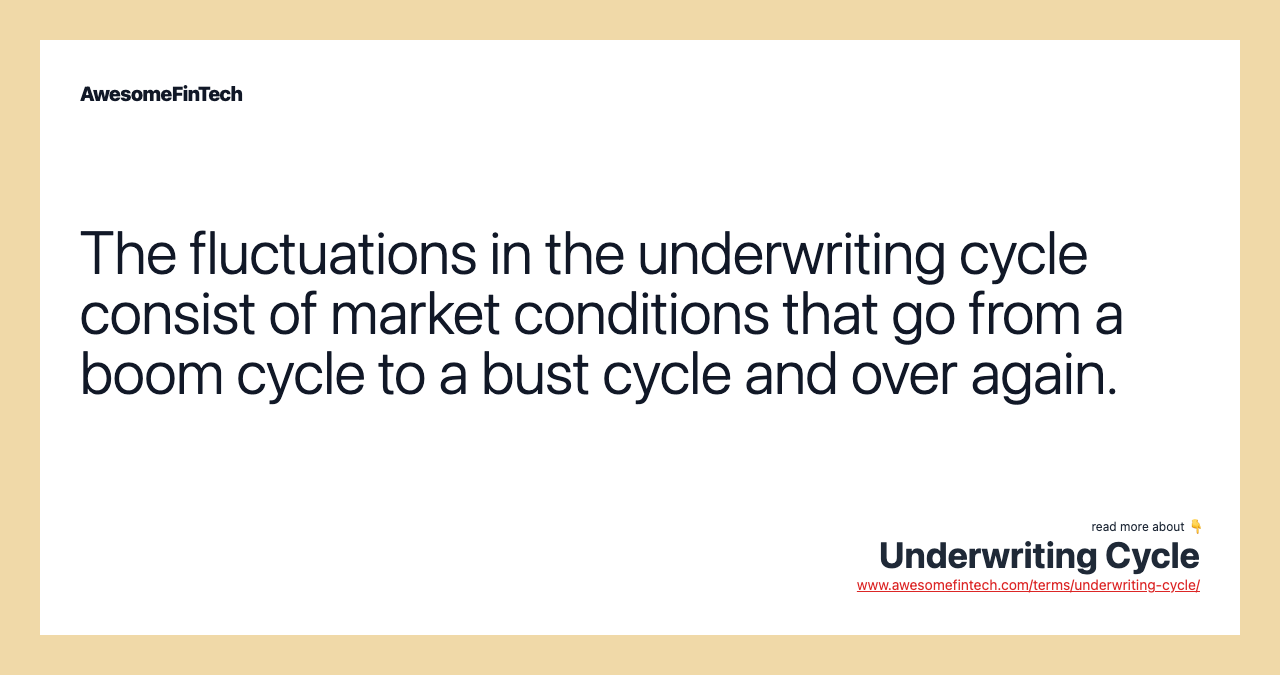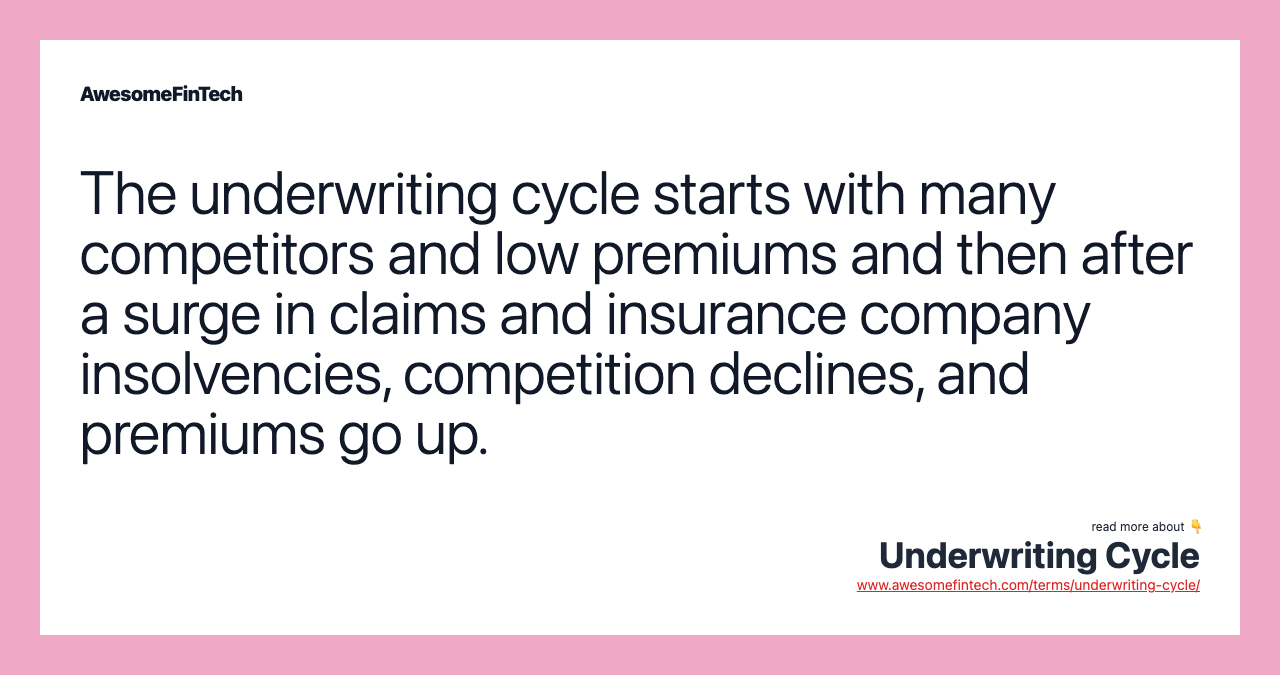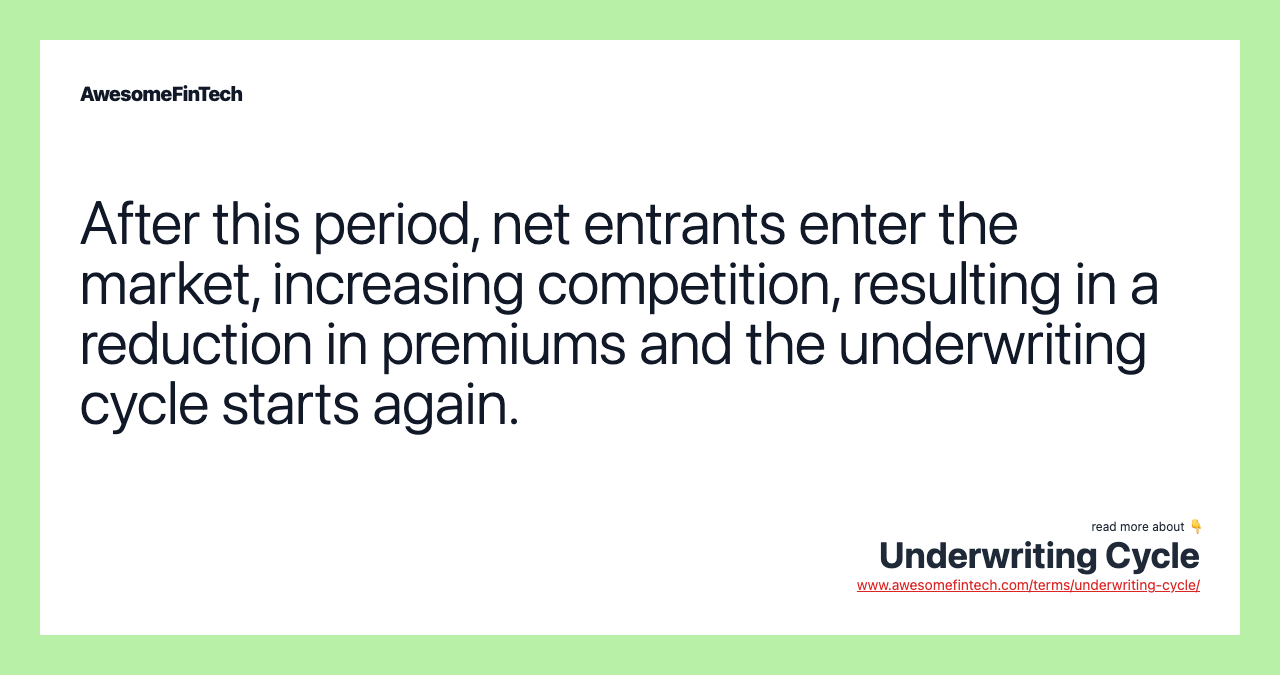Underwriting Cycle
The underwriting cycle refers to fluctuations in the insurance business over a period of time. The underwriting cycle affects all types of insurance except life insurance, where there is enough information to minimize risk and reduce the effect of the underwriting cycle. The underwriting cycle perpetuates because a majority of insurance companies place short-term gains over long-term stability, selling insurance without concern for what happens when the soft market ends. The fluctuations in the underwriting cycle consist of market conditions that go from a boom cycle to a bust cycle and over again. The underwriting cycle starts with many competitors and low premiums and then after a surge in claims and insurance company insolvencies, competition declines, and premiums go up.

What Is an Underwriting Cycle?
The underwriting cycle refers to fluctuations in the insurance business over a period of time. A typical underwriting cycle spans a number of years, as market conditions for the underwriting business go from boom to bust and back to boom again. An underwriting cycle is also known as an "insurance cycle."





Understanding an Underwriting Cycle
The underwriting cycle represents the ebb and flow of business between soft and hard insurance markets. At the beginning of an underwriting cycle, business is soft due to increased competition and excess insurance capacity, as a result of which premiums are low. Then, a natural disaster or other event leads to a surge in insurance claims, which drives lesser-capitalized insurers out of business.
Decreased competition and lower insurance capacity lead to better underwriting conditions for surviving insurers, enabling them to raise premiums and post solid earnings growth. As the insurance claims are paid off and the tide of new claims subsides, insurance companies slowly return to profitability. New insurance companies then enter the market, offering lower premiums and looser requirements than the existing companies. The existing companies are then compelled to loosen their requirements to stay competitive, and the insurance cycle starts all over again.
The underwriting cycle perpetuates because a majority of insurance companies place short-term gains over long-term stability, selling insurance without concern for what happens when the soft market ends. The only way to effectively regulate or insulate an insurance company against the effects of the insurance cycle is to ignore short-term profitability and focus on saving capital. An insurance company may also consider establishing limits and setting money aside in a "rainy day" type of account. Disciplined efficiency can have a considerable effect on a firm's financial stability and long-term business prospects.
Managing an Underwriting Cycle
As with most business cycles, the underwriting cycle is a phenomenon that is very difficult to eliminate. The concept has been an understood phenomenon since at least the 1920s and has since been treated as a core concept in the industry. In 2006, insurance giant Lloyd's of London identified managing this cycle as the top challenge facing the insurance industry and published a report by surveying more than 100 underwriters about industry issues. In response to their survey, they were able to identify steps to manage the insurance cycle.
Most insurance industry watchdog organizations believe that underwriting cycles are inevitable due to the inherent uncertainty of matching insurance prices to future losses. Unfortunately, the industry as a whole is not responding to the challenges the underwriting cycle brings. The underwriting cycle affects all types of insurance except life insurance, where there is enough information to minimize risk and reduce the effect of the underwriting cycle.
Related terms:
Accounting
Accounting is the process of recording, summarizing, analyzing, and reporting financial transactions of a business to oversight agencies, regulators, and the IRS. read more
Business Cycle : How Is It Measured?
The business cycle depicts the increase and decrease in production output of goods and services in an economy. read more
Cash Flow Underwriting
Using cash flow underwriting an insurer price a premium below its risk factor, hoping to generate investment capital from the increased business. read more
Earnings
A company's earnings are its after-tax net income, meaning its profits. Earnings are the main determinant of a public company's share price. read more
Fractal Markets Hypothesis (FMH)
Fractal markets hypothesis is a theory that seeks to explain sudden increases in market volatility and decreases in market liquidity. read more
Insurance Premium
An insurance premium is the amount of money an individual or business pays for an insurance policy. read more
Insurance
Insurance is a contract (policy) in which an insurer indemnifies another against losses from specific contingencies and/or perils. read more
Insurance Claim
An insurance claim is a formal request by a policyholder to an insurance company for coverage or compensation for a covered loss or policy event. The insurance company validates the claim and, once approved, issues payment to the insured. read more
Life Insurance Guide to Policies and Companies
Life insurance is a contract in which an insurer, in exchange for a premium, guarantees payment to an insured’s beneficiaries when the insured dies. read more